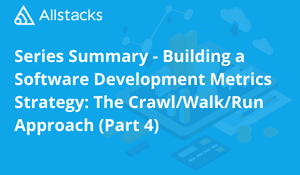If you've been following along, you've seen how a thoughtful, progressive approach to metrics can transform your development organization. If you're just joining us, this summary will catch you up on what you've missed.
If on the other hand you want to take a look at the whole series - here are the links:
Software Development Metrics - A Crawl, Walk, Run approach with Allstacks
Software Development Metrics - Taking Your First Steps in the Walk Phase with Allstacks
Welcome to the Run Phase: Mastering Software Engineering Metrics
The Importance of a Metrics Strategy
Let's start with why this matters so much: predictable portfolio delivery is the holy grail of software development. Business leaders need to know when features will ship, what resources are required, and whether investments are generating returns. Without a solid metrics strategy, organizations operate on gut feel and optimistic promises rather than data-driven confidence.
A well-designed metrics approach doesn't just improve visibility—it fundamentally transforms how teams work, how resources are allocated, and how business decisions are made. The Crawl/Walk/Run method provides a framework for building this capability incrementally, ensuring sustainable adoption and genuine improvement rather than metrics for metrics' sake.
The Crawl Phase: Establishing Foundations
We began our journey with the Crawl phase—the crucial first steps of any metrics program. Here, the focus is on establishing baselines and understanding your current state. By selecting just 3-4 key metrics (typically balancing speed and quality indicators), teams can gain visibility without drowning in data.
In this phase, Allstacks helps teams document their starting point, collect consistent measurements, and visualize results in accessible formats. The goal isn't perfection; it's creating a foundation of reliable data that reveals where improvement is most needed. Teams set modest, achievable goals for 2-3 months, focusing on stability and incremental gains rather than dramatic transformations.
The Walk Phase: Building Predictability
As teams master the basics, they enter the Walk phase, where the primary focus shifts to predictability. With baseline data in hand, organizations can now work deliberately toward consistent, reliable delivery patterns.
During this phase, the metrics portfolio expands to include deeper insights into code quality, operational efficiency, and team health. In this phase the big additions are qualitative information from the engineers themselves along with comparative industry data with metrics like Dora. Allstacks' portfolio investment tracking also becomes particularly valuable, helping leaders understand if resources are flowing to the right initiatives. Regular metrics rhythms become embedded in team practices, with daily dashboard checks, weekly trend analysis, and monthly deeper dives.
The Run Phase: Strategic Advantage
In the final Run phase, metrics evolve from tracking tools to strategic drivers. Executive dashboards connect technical measurements to business outcomes. Predictive analytics help teams anticipate challenges before they arise. External benchmarking provides essential context about industry performance.
A critical component of this phase is leveraging Allstacks' Investment Intelligence to bring unprecedented transparency to project portfolio performance. This powerful capability goes beyond traditional project tracking to reveal where engineering time and resources are actually being spent. Without this level of insight, organizations often operate on assumptions—you may think your highest-priority projects are getting the attention they deserve, but Investment Intelligence brings hard data to either verify or refute that feeling. It exposes the gap between perception and reality, revealing which teams are context-switching across too many projects and which initiatives are quietly consuming resources without delivering proportional value.
At this stage, metrics thinking becomes instinctive rather than forced. Teams proactively propose process changes based on data insights. Planning and retrospectives naturally incorporate metrics discussions. Most importantly, the human element remains central—metrics enhance engineering judgment rather than replacing it. The comprehensive portfolio visibility provided by Allstacks ensures resources align with strategic priorities and helps leaders make confident, data-driven decisions about where to invest engineering effort.
One Final thought - Expanding Your Metrics Mindset
Now that you've built your metrics muscle through this progressive approach, it's worth asking: where else in your software development ecosystem could this methodology create value?
The Crawl/Walk/Run framework can be applied across different development teams, technology stacks, or product lines within your organization. Perhaps you started with your core product team, but now your platform, mobile, or infrastructure teams could benefit from the same approach. Even within the same development organization, different projects or initiatives might be at different stages of metrics maturity. Consider how you might apply these principles to DevOps practices, QA processes, technical documentation teams, or developer enablement groups.
Each implementation follows the same pattern: start simple with baseline metrics, build toward predictability, and ultimately achieve strategic advantage through advanced analytics. Think of it as wash, rinse, repeat—a proven formula you can deploy again and again to transform software development through the power of meaningful measurement.
Thank You for Joining Our Metrics Journey
We want to sincerely thank everyone who's participated in this conversation over the past three weeks. Your engagement, questions, and insights have made this series more valuable for all involved. Building a metrics-driven culture isn't an overnight transformation, but with each step—from crawl to walk to run—you're creating a development organization that delivers more predictably, responds more effectively, and ultimately creates more value.
Remember: You can't improve what you don't measure, but you also can't measure effectively if you try to run before you can crawl. By embracing this methodical approach with Allstacks as your foundation, you'll build not just better metrics, but better software, happier teams, and stronger business outcomes.
We hope this series has provided practical guidance for your metrics journey. Whether you're just starting out or looking to elevate an existing program, the key is intentional progression and a focus on creating genuine value rather than just collecting numbers.
Here's to your continued success on the path to metrics mastery!
If you would like to engage in some further discussion regarding your metrics journey, reach out to discuss key engineering metrics!

Written By:





